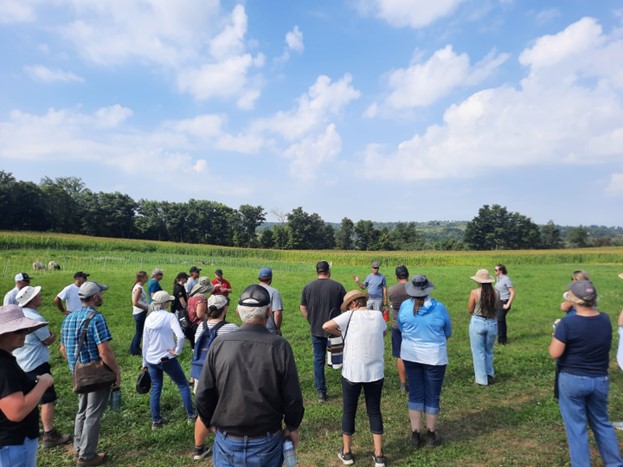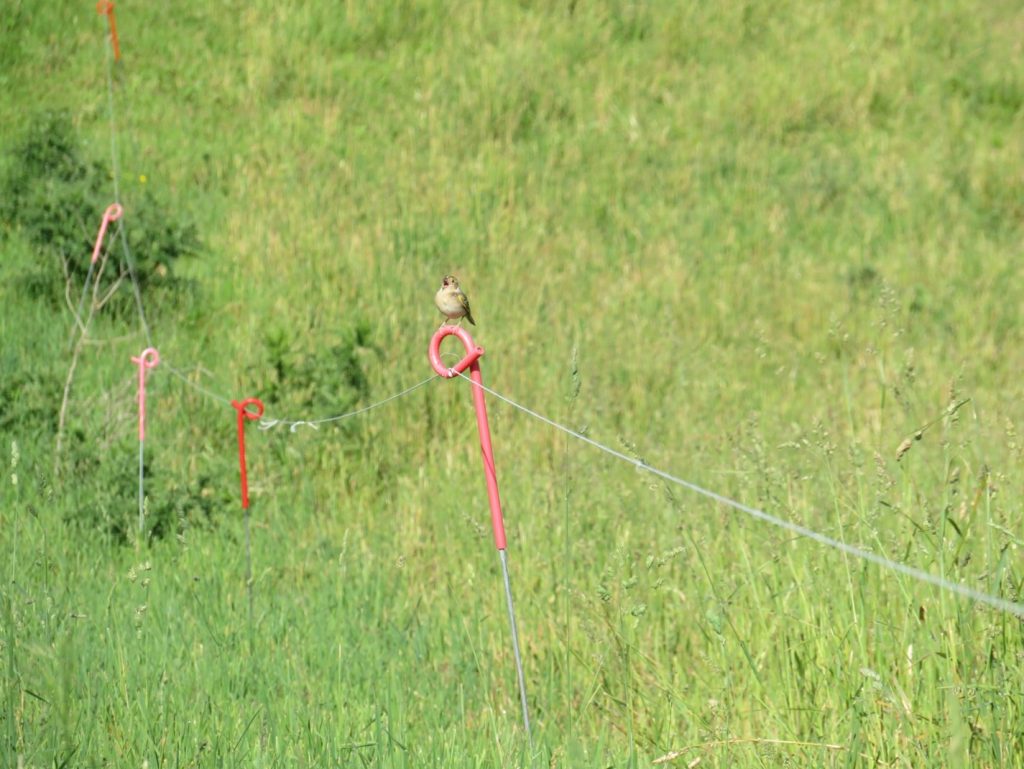By: Madeline Rodrigue, Knowledge Mobilization Specialist at OSCIA
Tailgate tours, field days and other opportunities for farmer-to-farmer learning hold an important place in agriculture. They offer the opportunity to ask questions, share collective wisdom and see practices in action. Earlier this fall, the Ontario Soil and Crop Improvement Association (OSCIA) hosted two engaging farm events that were supported by the Species at Risk Farm Incentive Program (SARFIP) and the Ontario On-Farm Climate Action Fund (OFCAF).
SARFIP provides funding to agricultural landowners who complete habitat creation, enhancement, and protection Best Management Practices (BMPs) that support species at risk (SAR). Similarly, OFCAF offers cost-share funding to farmers to implement BMPs aimed at climate change mitigation by reducing greenhouse gas emissions and enhancing carbon sequestration. These two programs converge in their support of farmers adopting rotational grazing systems.
On September 6, Norm Lamothe welcomed participants to Woodleigh Farms in Cavan Monaghan, where a wide range of BMPs that have been adopted over the last decade are on display, including reduced tillage, cover cropping, on-farm composting, and precision agriculture. Participants were treated to a firsthand look at the farm’s exciting developments, including an Operation Pollinator habitat planted in the field margins and the reintroduction of livestock to their farm with a newly established rotational grazing system for sheep. Norm explained how adding rotational grazing is intended to minimize the farm’s reliance on commercial fertilizers and herbicides. Livestock serve as a natural recycler of nutrients while grazing on weeds and cover crop residue that would typically have to be managed by chemical termination or mowing. All these practices have been integrated into the farm system to build soil health and reduce the carbon footprint while prioritizing profitability, making the farm more resilient.

Guest speakers Cayla Darling and Kaitlyn Hall, Species at Risk Ecologists with Blazing Star Environmental, discussed the significance of agricultural land as habitat for grassland bird species that nest on the ground in pastures and hayfields. They also walked participants through a grassland bird identification demonstration using bird calls. Farmers who successfully apply to the SARFIP program can volunteer to participate in a monitoring program called SAR Watch (Species at Risk Watch). As part of SAR Watch, landowners provide more in-depth information about the types of habitats on their properties and any species at risk they’ve seen or have been observed by others. A biologist completes a site visit to assess the benefit of the SARFIP project.
The second event, held on September 16, was hosted by Peter Kotzeff, a beef veterinarian and farmer in Bruce County. Peter shared his journey of turning marginal land into a thriving and profitable agricultural ecosystem. Attendees enjoyed a wagon tour of Peter’s farm, showing how rotational cattle grazing, minimal tillage, cover crops, wildlife corridors and crop rotations have been integrated to improve soil structure and nutrient availability while protecting nearby riverbanks, wetlands, and other vital habitats.

Attendees at the event had the opportunity to hear from Zoe Lebrun-Southcott and Andrew Campomizzi from Bird Ecology and Conservation Ontario (BECO). BECO conducts field research and monitoring to better understand the relationship between grassland birds and farm management. Some of this research took place on one of Peter’s farms. They outlined how rotational grazing practices can be modified (e.g., delayed grazing, light spring grazing) to minimize the impact on nesting periods of grassland birds, such as the Bobolink, Meadowlark and Grasshopper Sparrow. Kim Schneider, Assistant Professor at the University of Guelph, also discussed her research looking at the ecosystem services provided by forage and service crops, such as soil carbon sequestration.

Norm and Peter believe sustainable agriculture is not merely a lofty ideal but a practical path to long-term success in farming. They are eager to share their knowledge and experience, while also being open to learning from others and hoping farmers are encouraged to adopt or experiment with more resilient practices. Both tours were Knowledge Sharing Events (KSEs), a learning requirement integrated into the OFCAF program that encourages approved applicants to participate in at least one learning opportunity to support the successful long-term adoption of their new practice.
These events demonstrated how rotational grazing can yield positive outcomes for farmers, species at risk conservation and climate change mitigation. Programs like SARFIP and OFCAF play a fundamental role in supporting farmers in adopting these practices while providing opportunities for continued learning.